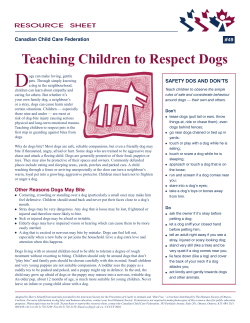
Fact Sheet HEARTWORM DISEASE
Fact Sheet HEARTWORM DISEASE The following details have been supplied in order to give you some information should your dog have been diagnosed as having heartworm disease. What causes heartworm disease? Heartworm disease (dirofilariasis) is a serious and potentially fatal disease in dogs in many parts of the world. It is caused by a worm called Dirofilaria immitis. This disease has been actively present in South Australia since 1988. Heartworms are found in the heart and large adjacent vessels of infected dogs. The female worm is 2.3 to 5.5 cm long and 5 mm wide; the male is about half the size of the female. One dog may have as little as 1 or as many as 300 adult worms. How do dogs get heartworm? Adult heartworms live in the heart and pulmonary arteries of infected dogs. They have been found in other areas of the body, but this is unusual. They survive up to 5 years and, during this time; the female produces millions of young (microfilaria). These microfilaria live in the bloodstream, mainly in the small blood vessels. The immature heartworms cannot complete the entire life cycle in the dog; a mosquito is required for some stages of the heartworm life cycle. The microfilaria are therefore not infective (cannot grow to adulthood) in the dog. As many as 30 species of mosquitoes can transmit heartworms. The female mosquito bites the infected dog and ingests the microfilariae during a blood meal. The microfilariae develop further for 10 to 30 days in the mosquito and then enter the mouthparts of the mosquito. The microfilariae are now called infective larvae because at this stage of development, they will grow to adulthood when they enter a dog When fully developed, the infective larvae enter the bloodstream and move to the heart and adjacent vessels, where they grow to maturity in 2 to 3 months and start reproducing, thereby completing the full life cycle. 571 Montague Road, Modbury PO Box 571, Modbury, 5092 Telephone (08) 8397 7444 www.teatreegully.sa.gov.au How do dogs get infected with them? The disease is not spread directly from dog to dog. An intermediate host, the mosquito, is required for transmission. It can take a number of years before dogs show outward signs of infection. Consequently, the disease is diagnosed mostly in 4 to 8 year old dogs. The disease is seldom diagnosed in a dog less than 1 year of age because the young worms (larvae) take up to 7 months to mature following establishment of infection in a dog. What do heartworms do to the dog? Adult worms: Adult worms cause disease by clogging the heart and major blood vessels leading from the heart. They interfere with the valve action in the heart. By clogging the main blood vessels, the blood supply to other organs of the body is reduced, particularly the lungs, liver and kidneys, leading to malfunction of these organs. The signs of heartworm disease depend on the number of adult worms present, the location of the worms, the length of time the worms have been present, and the degree of damage to the heart, lungs, liver, and kidneys from the adult worms. The most obvious signs are: a soft, dry, chronic cough, shortness of breath, weakness, nervousness, listlessness, and loss of stamina. All of these signs are most noticeable following exercise, when some dogs may even faint. Listening to the chest with a stethoscope will often reveal abnormal lung and heart sounds. In advanced cases, congestive heart failure may be apparent and the abdomen and legs will swell from fluid accumulation. There may also be evidence of weight loss, poor condition, and anaemia. Severely infected dogs may die suddenly during exercise or excitement, sometimes with no other indication that the dog was unwell. Microfilariae (Young worms): Microfilariae circulate throughout the body but remain primarily in the small blood vessels. Because they are as wide as the small vessels, they may block blood flow in these vessels. The body cells being supplied by these vessels may be deprived of the nutrients and oxygen normally supplied by the blood. The lungs, liver and kidney are primarily affected. Generally however the changes produced by the microfilaria are not particularly significant. How is heartworm infection diagnosed? In most cases, diagnosis of heartworm disease can be made by a blood test that can be run by the veterinary practice. Further diagnostic procedures are essential, in advanced cases particularly, to determine if the dog can tolerate heartworm treatment. Depending on the case, we will recommend some or all of the following procedures before treatment is started. Serological test for antigens to adult heartworms: This is a test performed on a blood sample. It is the most widely used test because it detects antigens (proteins) produced by adult heartworms. It will be positive even if the dog does not have any microfilaria in the blood; this occurs between 10-50% of the time. Like all tests there will occasionally be a false positive or false negative test. Blood test for microfilariae: A blood sample is examined under the microscope for the presence of microfilariae. If microfilariae are seen, the test is positive. The number of microfilariae seen gives us a general indication of the severity of the infection. However, the microfilariae are seen in greater numbers in the summer months and in the evening, so these variations must be considered. Approximately 10-50% of dogs do not test positive even though they have heartworms because of an acquired immunity to this stage of the heartworm. Also, there is another microfilarial parasite which is fairly common in dogs; on the blood smear, these can be hard to distinguish from heartworm microfilariae. Blood chemistries: Complete blood counts and blood tests for kidney and liver function may give an indirect indication of the presence of heartworm disease. These tests may be performed on dogs diagnosed as heartworminfected to determine the function of the dog’s organs prior to treatment. Radiographs (X-rays): A radiograph of a dog with heartworms will usually show heart enlargement and swelling of the large artery leading to the lungs from the heart. These signs are considered presumptive evidence of heartworm disease. Radiographs may also reveal the condition of the heart, lungs, and vessels. This information allows us to predict an increased possibility of complications related to treatment. Ultrasonography (Ultrasound scan): An echocardiogram allows us to see into the heart chambers and visualise the heartworms themselves. Although somewhat expensive, this procedure can diagnose heartworms when other tests fail. How are dogs treated for heartworm infection? There is some risk involved in treating dogs with heartworms, although fatalities are rare. The drug that is used contains arsenic. The amount of arsenic is sufficient to kill heartworms without undue risk to the dog. However, dogs with poor liver or kidney function may have difficulty breaking down and eliminating the arsenic. In spite of this we are able to treat more than 95% of dogs with heartworms successfully. Some dogs can have advanced heartworm disease. This means that the heartworms have been present long enough to cause substantial damage to the heart, lungs, blood vessels, kidneys, and liver. A few of these cases will be so far advanced that it will be safer to just treat the organ damage rather than risk treatment to kill the worms. Dogs in this condition are not likely to live more than a few weeks or months. Treatment to kill adult worms: An injectable drug to kill adult heartworms is given for two days. It kills the adult heartworms in the heart and adjacent vessels over a period of about 30 days. Complete rest is essential after treatment. Some adult worms die in a few days and start to decompose; the remainder will die within a month. As they break up, they are carried to the lungs, where they lodge in the small blood vessels and are eventually reabsorbed by the body. This is a dangerous period, and it is absolutely essential that the dog be kept quiet and not be allowed to exercise for 1 month following treatment. The first week after the injections is very critical because the worms are dying. A cough is noticeable for 7 to 8 weeks after treatment in many heavily infected dogs. Prompt treatment is essential if the dog has a significant reaction in the weeks following the initial treatment, although such reactions are not common. If a dog shows loss of appetite, shortness of breath, severe coughing, coughing up blood, fever, and/or depression, treatment will be necessary. Response to antibiotics, cage rest, and supportive care, such as intravenous fluids, is usually good in these cases. Treatment to kill microfilaria: Approximately one month following treatment to kill the adults, the dog then undergoes administration of a drug to kill microfilariae. Your dog needs to stay in the hospital for the day. Four weeks later a test is performed to determine if microfilariae are present. If they have been all killed, the treatment is complete. If there are still some present in the blood, treatment for microfilariae is repeated. Other treatments: In dogs with severe heartworm disease, it may be necessary to treat them with antibiotics, anticoagulants to thin the blood, diuretics to remove fluid accumulations, and drugs to improve heart function prior to treatment for the heartworms. Dogs with severe heart disease may need lifetime treatment for the failing heart, even after the heartworms have been killed. This includes the use of diuretics and heart drugs. Response to treatment: Dog owners are usually pleasantly surprised at the change in their dog following treatment for heartworms, especially if the dog had been showing signs of heartworm disease. The dog has a renewed vigor and vitality, improved appetite, and weight gain. Carole Benassy Drs. Baker, Rickman, Hart, Hodgkin & Steyn Office Address: 1269 North East Road, Ridgehaven 5097 Phone 08 8396 2331 Fax 08 8264 5730 www.vets4pets.com.au admin@vets4pets.com.au
© Copyright 2025



















